Ohio, with its multitude of lakes, rivers, and marshlands, boasts a rich variety of water bird species. Among these, 25 distinctive types offer a vibrant tapestry of avian biodiversity, enriching the state’s natural heritage.
Ohio water birds
Ohio, with its large bodies of water and various habitats, is home to a variety of water bird species. Here are some of the most common water birds you might find in Ohio
| Species | Frequency | Where to Find in Ohio |
|---|---|---|
| Double-Crested Cormorant | Common | Lake Erie, Buckeye Lake |
| Great Blue Heron | Common | Cuyahoga Valley National Park, Ottawa National Wildlife Refuge |
| Great Egret | Common | Magee Marsh Wildlife Area, Ottawa National Wildlife Refuge |
| Snowy Egret | Uncommon | Ottawa National Wildlife Refuge |
| Green Heron | Common | Killbuck Marsh Wildlife Area, Springfield Bog Metro Park |
| Black-Crowned Night-Heron | Uncommon | Ottawa National Wildlife Refuge, Magee Marsh Wildlife Area |
| Mallard | Very Common | Throughout the state in various ponds, lakes and rivers |
| Wood Duck | Common | Cuyahoga Valley National Park, Mohican State Park |
| Blue-Winged Teal | Common | Ottawa National Wildlife Refuge, Metzger Marsh Wildlife Area |
| Northern Pintail | Common | Ottawa National Wildlife Refuge, Pickerel Creek Wildlife Area |
| Canvasback | Common | Lake Erie, Hoover Reservoir |
| Redhead | Common | Lake Erie, East Fork State Park |
| Ring-Necked Duck | Common | Caesar Creek State Park, Magee Marsh Wildlife Area |
| Bufflehead | Common | Lake Erie, East Fork State Park |
| Hooded Merganser | Common | Hoover Reservoir, East Fork State Park |
| Common Merganser | Common | Cuyahoga Valley National Park, Lake Erie |
| American Coot | Common | Ottawa National Wildlife Refuge, Buckeye Lake |
| Sandhill Crane | Uncommon | Killbuck Marsh Wildlife Area, Funk Bottoms Wildlife Area |
| American Wigeon | Common | Lake Erie, Magee Marsh Wildlife Area |
| Canada Goose | Very Common | Throughout the state in various ponds, lakes and rivers |
| Green winged teal | Common | Lake Erie, Magee Marsh Wildlife Area |
| Killdeer | Uncommon | Lake Erie, Alum Creek State Park |
| Common Loon | Uncommon | Lake Erie, Alum Creek State Park |
| Pied-Billed Grebe | Common | Ottawa National Wildlife Refuge, Magee Marsh Wildlife Area |
| American Bittern | Uncommon | Ottawa National Wildlife Refuge, Killbuck Marsh Wildlife Area |
Water Bird Species Found in Ohio
Canada Goose
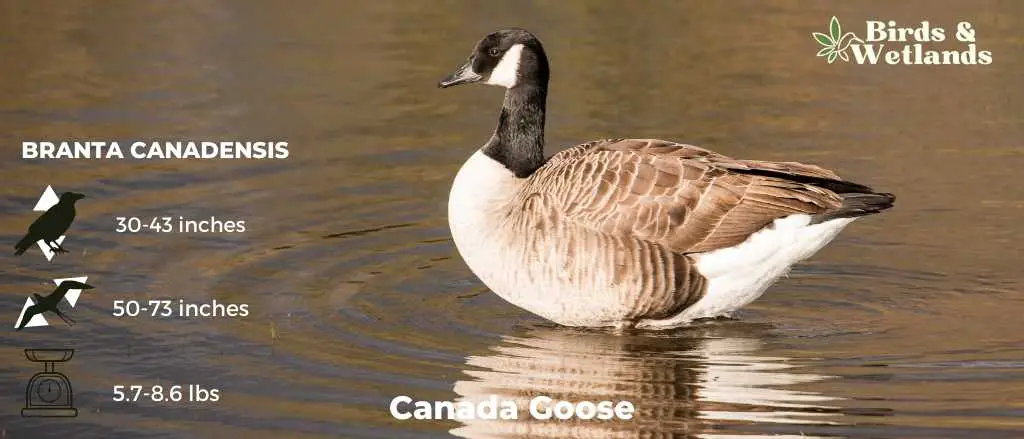
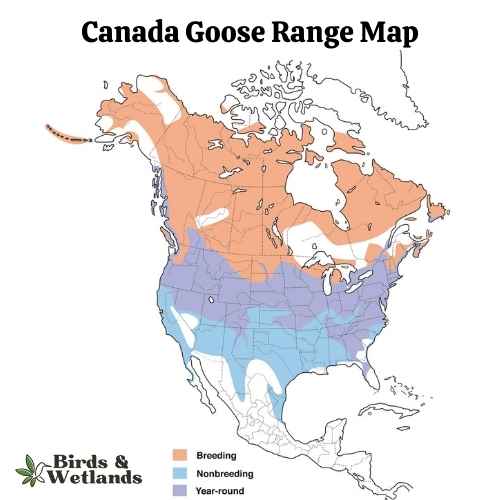
Canada Goose Sound
Scientific Name: Branta canadensis
Length: 30 to 43 in
Wingspan: 50–73 in
Weight: 5.7–14.3 lb
The Canada Goose is a large, well-known species of waterfowl noted for its distinctive appearance, familiar “honk,” and migratory behavior.
Appearance: Both male and female Canada Geese have a similar appearance, featuring a black head and neck with distinctive white patches on the cheeks and chin. The body is primarily brown with a lighter, often white, underbelly.
Diet: Canada Geese primarily feed on plant matter, including grasses, aquatic vegetation, and grains. They can often be seen grazing in parks, lawns, and fields, as well as dabbling in water bodies.
Reproduction: Canada Geese typically nest on the ground near water bodies, often on islands or other isolated areas to avoid predators. The female lays a clutch of about 4 to 6 eggs, which she incubates alone for around a month.
Killdeer
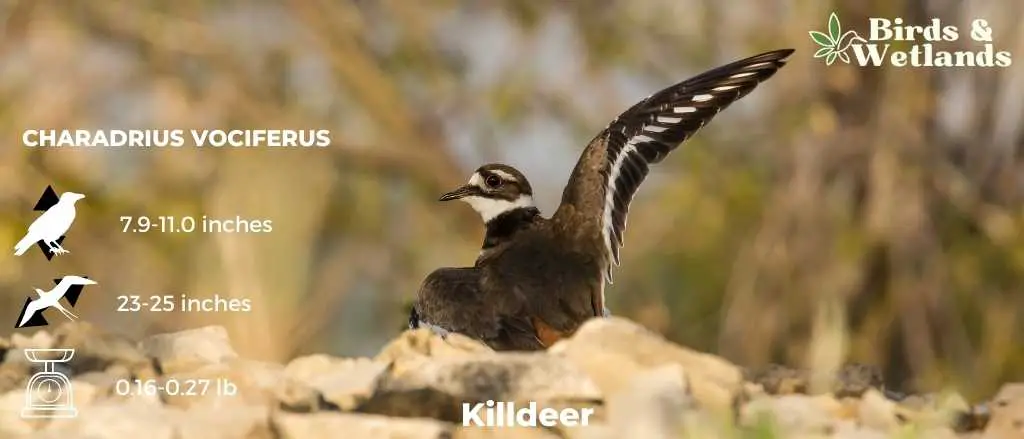
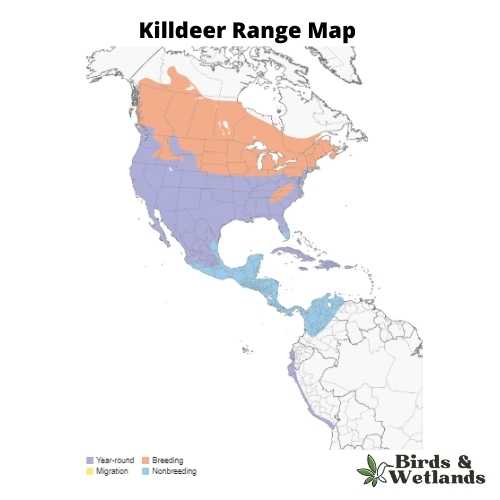
Listen:
Scientific Name: Charadrius vociferus
Length: 7.9 to 11.0 in
Wingspan: 23 and 25 in
Weight: 2.5 and 4.3 oz
The Killdeer is a widespread and conspicuous bird known for its distinctive call and interesting nesting habits.
Appearance: Killdeer are medium-sized birds with brown backs and white undersides. They’re easily identifiable by their double black neck rings and orange rump that’s visible during flight. Their long, pointed wings and rapid flight give them a somewhat lark-like appearance.
Diet: The diet of Killdeer primarily consists of invertebrates such as beetles, worms, snails, and spiders, though they occasionally eat seeds and small fruits as well. They usually forage by walking and pecking or scurrying in short spurts in search of food.
Reproduction: Killdeers prefer to nest on open ground with good visibility, often in rather unexpected places like gravel roads or driveways. The nest itself is a simple scrape in the ground, which the female lines with grass, pebbles, or other debris. The female usually lays around 4 to 6 eggs.
Green-winged Teal
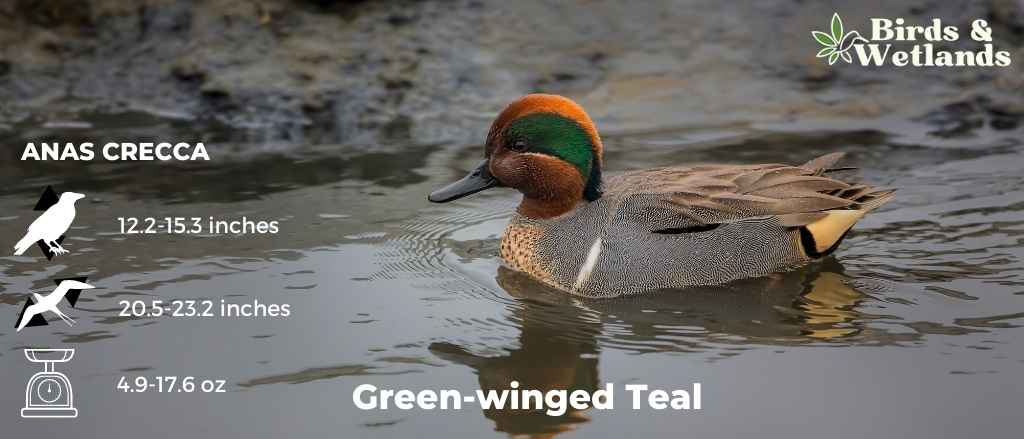
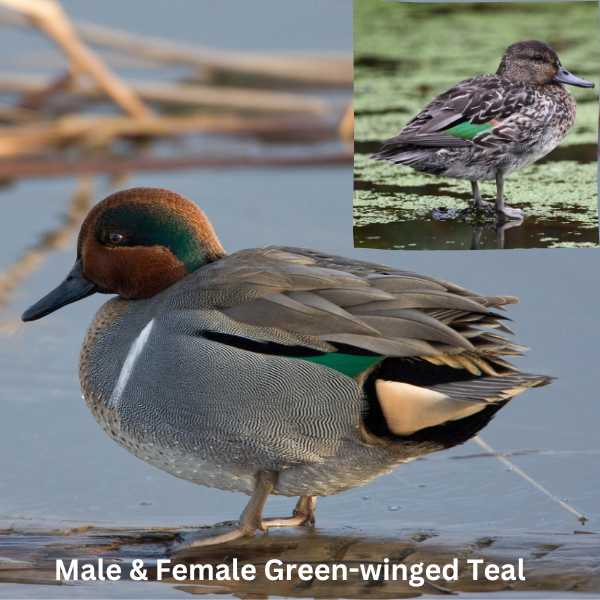
Listen to Green-winged Teal
Scientific Name: Anas crecca
Length: 12.2-15.3 in
Wingspan: 20.5-23.2 in
Weight: 14.9-17.6 oz
The Green-winged Teal is a small species of dabbling duck known for its vibrant coloration and quick, agile flight.
Appearance: Male Green-winged Teals are particularly striking with a chestnut head, a broad green streak running from the eye down the neck, and a speckled chest. The name “Green-winged” originates from the patch of iridescent green feathers visible on their wings. Females are more subtly colored, primarily in mottled brown tones that provide excellent camouflage.
Diet: The Green-winged Teal’s diet consists largely of plant matter such as seeds and aquatic vegetation. They also eat small invertebrates, particularly during the breeding season. These birds are ‘dabblers.’
Reproduction: Green-winged Teals typically nest on the ground, often concealed in dense vegetation near water bodies. The female lays a clutch of about 6 to 9 eggs, which she incubates alone for roughly three weeks.
Double-crested cormorant

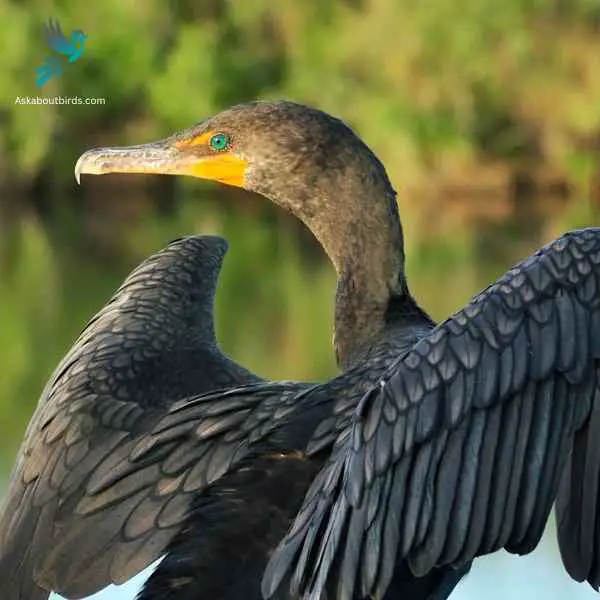
| Feature | Measurement |
|---|---|
| Scientific Name | Nannopterum auritum |
| Length | 28–35 in |
| Wingspan | 45–48 in |
| Weight | 1.2–2.5 kg |
The Double-Crested Cormorant (Phalacrocorax auritus) is a large waterbird known for its long neck, hooked bill, and almost entirely black body. The species gets its name from the two small patches of tufted feathers or “crests” found on the heads of breeding adults, one on each side. These birds are strong swimmers that propel themselves underwater with their webbed feet, their bodies submerged and necks above the water surface, giving them a characteristic snake-like appearance when swimming.
Double-Crested Cormorants are widely distributed across North America and can be found in a variety of aquatic environments including freshwater lakes, coastal areas, and rivers. Their diet primarily consists of fish, which they catch by diving from the water’s surface. Often seen perched with wings outstretched to dry after fishing, these cormorants nest in trees, on the ground, or on cliff edges, usually in colonies. While they have rebounded from decreases in the mid-20th century due to DDT-related reproductive failures, they face ongoing threats from habitat loss, entanglement in fishing gear, and conflicts with fisheries over their consumption of fish. Protection and careful management of their habitats are key to their ongoing conservation.
Great Blue Heron


| Feature | Measurement |
|---|---|
| Scientific Name | Ardea herodias |
| Length | 36–54 in |
| Wingspan | 66–79 in |
| Weight | 1.82–3.6 kgs |
Great Blue Herons are the largest heron species in North America, is distinguished by its tall stature and unique blue-gray plumage.
Measuring up to 4.5 feet tall with a wingspan of approximately 6.5 feet, the bird features a long, pointed bill, a white head with a black eye stripe extending to slender black plumes, and robust, elongated legs. Its distinctive flight pattern, forming a tight “S” shape with its neck, sets it apart from similar large birds, like cranes.
Inhabiting various wetland habitats, including marshes, lakes, rivers, and coastal regions throughout much of North and Central America, the Great Blue Heron is a wading bird. Often seen poised statue-like at the water’s edge, these birds are expert hunters, spearing fish and capturing small animals with their sharp bills.
Great Egret


| Feature | Measurement |
|---|---|
| Scientific Name | Ardea alba |
| Length | 31 to 41 in |
| Wingspan | 52 to 67 in |
| Weight | 1.5 to 3.3 lbs |
The Great Egret (Ardea alba), also known as the Common Egret, is a large, elegant wading bird recognized for its brilliant white plumage, slender black legs, and long, dagger-like yellow bill.
With a height of up to 3.3 feet and a wingspan of 52 to 67 inches, this bird is amongst the largest of the heron species. Its stately appearance and serene comportment have made it a popular symbol in many cultures and an eye-catching sight in its habitats.
Found across all continents except Antarctica, the Great Egret resides in both fresh and saltwater wetlands, including marshes, ponds, and coastal areas. It feeds mainly on fish, but it also hunts amphibians, small mammals, and invertebrates.
Snowy Egret

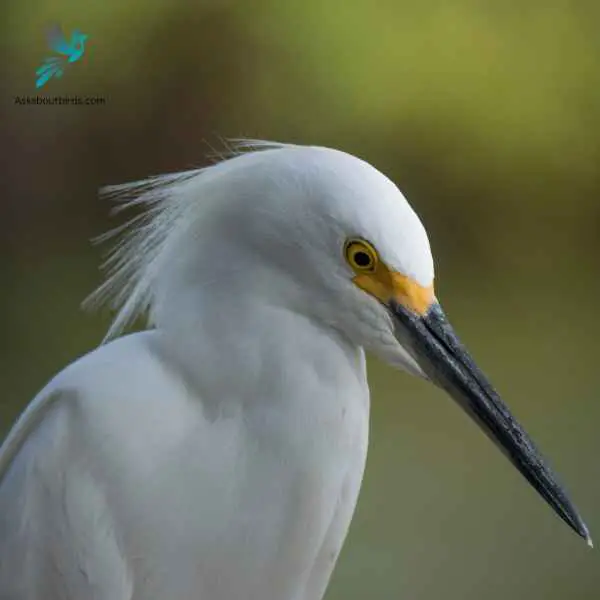
| Feature | Measurement |
|---|---|
| Scientific Name | Egretta thula |
| Length | 22.1–26.0 in |
| Wingspan | 39.4 in |
| Weight | 370 g |
The Snowy Egret (Egretta thula) is a small and active wading bird, celebrated for its delicate beauty. It sports an entirely white plumage that appears to glow against its black bill and legs, and striking yellow feet, which often play a crucial role in luring prey during feeding.
The Snowy Egret is further adorned with fine, plume-like feathers on its head, neck, and back during the breeding season, making it one of the more distinctive heron species.
Inhabiting wetland areas across the Americas, the Snowy Egret can be found in marshes, swamps, shorelines, and tidal flats where it feeds primarily on fish, but also consumes insects, crustaceans, and small reptiles.
Green Heron

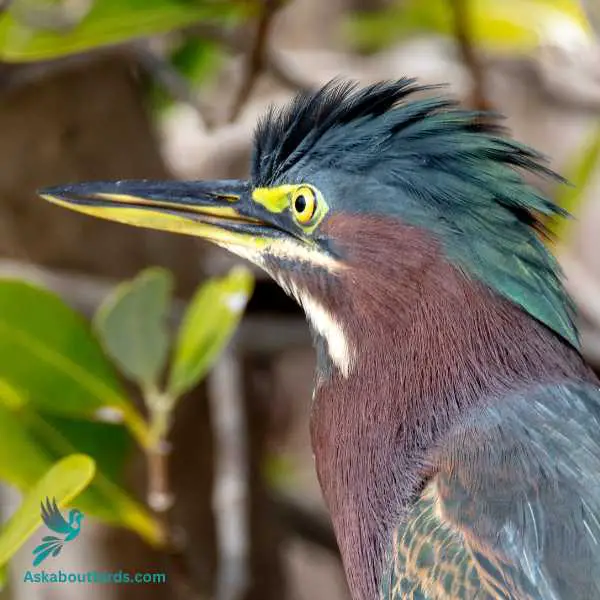
| Feature | Measurement |
|---|---|
| Scientific Name | Butorides virescens |
| Length | 16-18 inches |
| Wingspan | 25-27 inches |
| Weight | 6-7 ounces |
The Green Heron is a small heron found in North America, notable for its deep green back and chestnut body, as well as its unique fishing tactics.
Appearance: Green Herons are dark and compact birds with a glossy, greenish-black cap, a greenish back and wings, and chestnut neck and belly. The bill is long, dark and sharply pointed. Their legs are bright orange or yellow. Young birds are duller in color, with a dark top and streaked brown front.
Diet: The Green Heron’s diet is quite varied, consisting mostly of small fish, but also includes insects, spiders, and sometimes amphibians and small mammals. It’s known for its tool-using behavior where it drops bait onto the water’s surface to attract fish.
Reproduction: Green Herons are solitary birds except during the breeding season, where they form monogamous pairs. Nests are typically built in trees or shrubs near water. Females lay 2 to 5 pale blue-green eggs that both parents incubate.
Black-Crowned Night-Heron
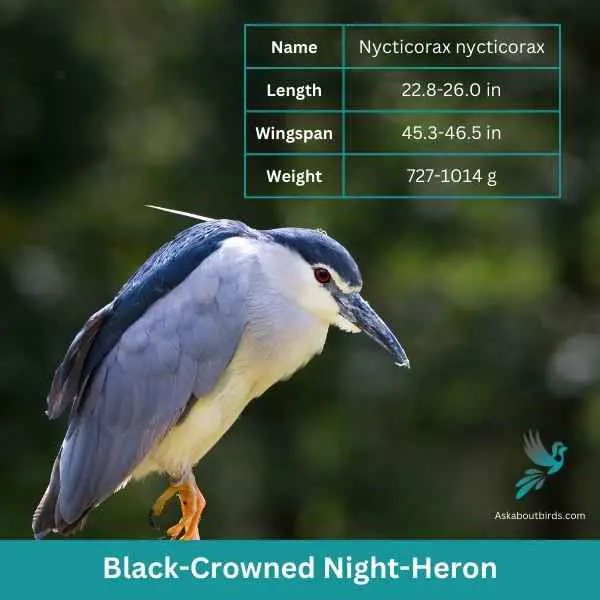
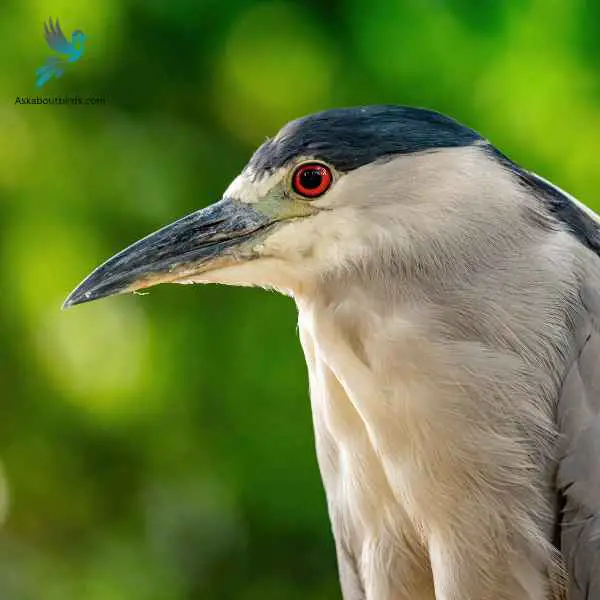
| Feature | Measurement |
|---|---|
| Scientific Name | Nycticorax nycticorax |
| Length | 22.8-26.0 in |
| Wingspan | 45.3-46.5 in |
| Weight | 727-1014 g |
The Black-Crowned Night-Heron (Nycticorax nycticorax) is a medium-sized heron species known for its distinct nocturnal habits and characteristic appearance. The bird displays a stocky silhouette, with a black crown and back, contrasting starkly with its light grey wings and white underparts.
Its eyes are large and red, adapted for its night-time activities, and its legs are relatively short for a heron. The bill is sturdy and black, and during the breeding season, two to three long white plumes extend from the back of the head.
Residing in a wide variety of wetland habitats, from freshwater marshes to coastal regions, the Black-Crowned Night-Heron is found across a large global range, including the Americas, Europe, Asia, and Africa. The species primarily feeds on fish and invertebrates, but it is known to be opportunistic and will also eat small mammals, birds, and eggs.
Yellow-crowned Night-Heron (Nyctanassa violacea)

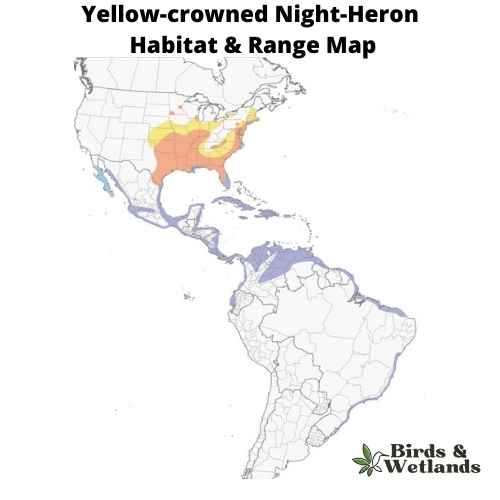
Listen:
Scientific Name: Nyctanassa violacea
Length: 1 ft 10 in – 2 ft 4 in
Wingspan:
Weight: 1.43–1.87 lb
The Yellow-crowned Night Heron is a medium-sized heron commonly found in wetlands and coastal habitats across the southeastern United States.
Appearance: Yellow-crowned Night Herons have a sturdy body with a comparatively short neck and legs. Their distinctive feature is their namesake yellow crown, which contrasts sharply with their gray body and back. They have red eyes and a heavy, dark bill. During the breeding season, they develop long, wispy plumes on their head, giving them a stylish appearance.
Diet: Yellow-crowned Night Herons are known for their preference for crustaceans, especially crabs and crayfish. They hunt mostly at night, stalking their prey in shallow water, often remaining still for long periods before striking quickly with their bill.
Reproduction: Yellow-crowned Night Herons nest in small colonies, typically in trees or shrubs near water. The female lays 3 to 5 pale blue-green eggs which are incubated by both parents for about 25 days. After hatching, the chicks are cared for by both parents and fledge in about 30-40 days. They often return to the same nesting sites year after year.
Mallard

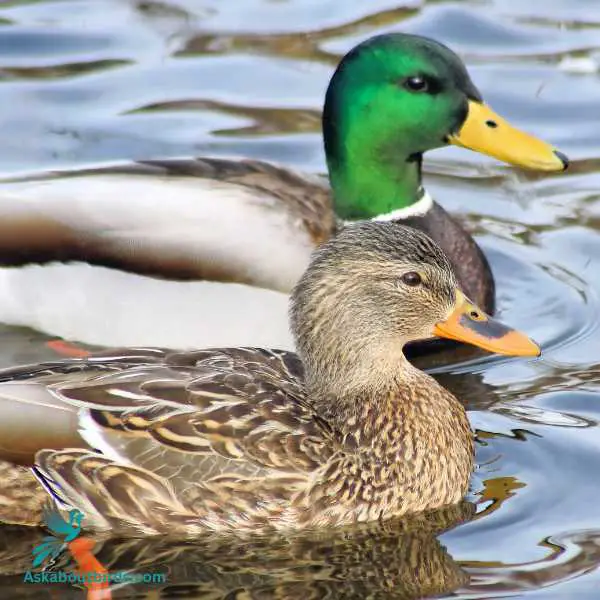
| Feature | Measurement |
|---|---|
| Scientific Name | Anas platyrhynchos |
| Length | 20-26 inches |
| Wingspan | 32-39 inches |
| Weight | 1.6-3.5 pounds |
The Mallard, one of the most recognizable of all ducks, is distinguished by its classic “quack” and its common presence in city parks and wild wetlands.
Appearance: Mallards are large ducks with a hefty body and rounded head. The male is notable for its glossy green head, gray body, and black tail-curl, while the female is mottled brown with an orange-brown bill. Both sexes have a white-bordered, blue “speculum” patch in the wing.
Diet: Mallards are omnivorous, dabbling ducks that eat a wide variety of foods. They are known to feed on aquatic vegetation, insects, worms, and grains. In city parks, they are often seen eating bread, popcorn, and other food provided by humans, although such items are not part of their natural diet.
Reproduction: Mallards nest on the ground on dry land that is close to water, under cover of tall grass or other vegetation. The female typically lays around 8 to 13 eggs and incubates them herself.
Wood Duck
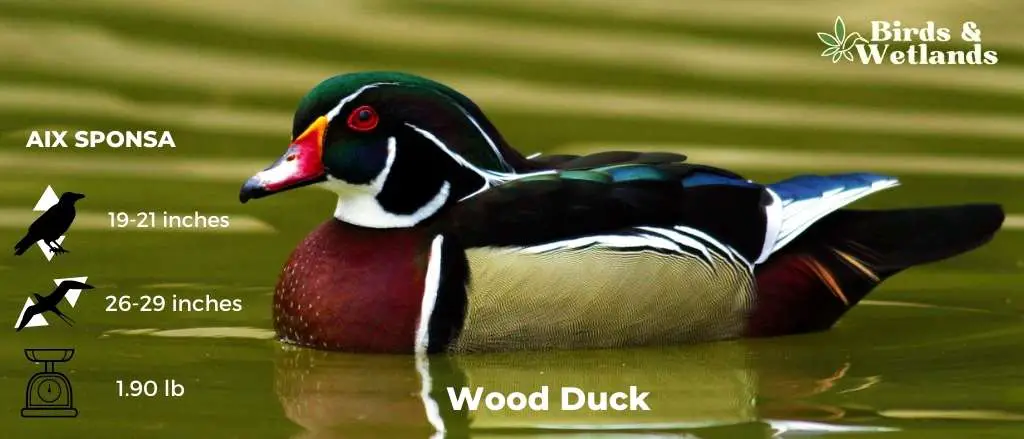
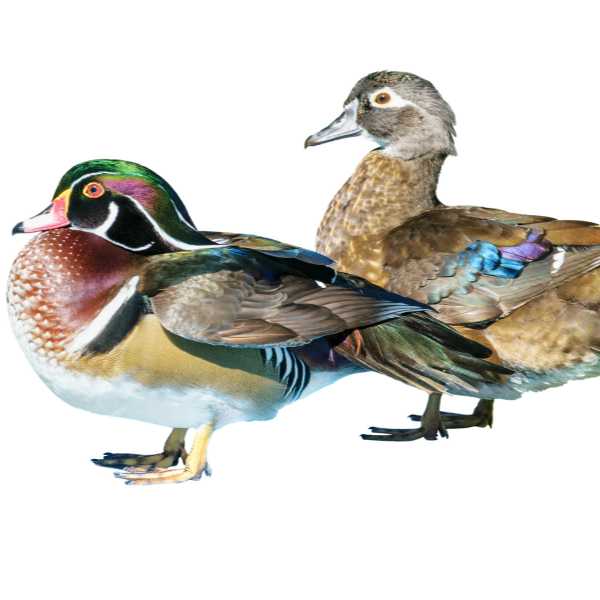
Listen:
Scientific Name: Aix sponsa
Length: 19 to 21 in
Wingspan: 26 to 29 in
Weight: 16.0-30.4 oz
The Wood Duck is an exquisitely colorful waterfowl known for its unique nesting habits and is commonly seen in wooded swamps, marshes, and streams across North America.
Appearance: With their dazzling plumage, Wood Ducks are among the most stunning birds. Males display a multitude of colors, including a green and purple crested head, red eyes, and a white-striped chest, all contrasted with a bronze-colored body. Females, though more subdued with a gray-brown body and white eye-ring, also possess their own charm.
Diet: Wood Ducks have a diverse diet that includes seeds, fruits, and insects, as well as other invertebrates. Their broad diet helps them to adapt to a variety of habitats, whether in the wild or in urban areas with suitable nesting sites.
Reproduction: Unlike most other ducks, Wood Ducks prefer to nest in tree cavities near water, leading to their common name. They will also readily use nest boxes if they’re available. A typical clutch consists of 9 to 14 eggs, which the female incubates alone.
Blue-winged Teal
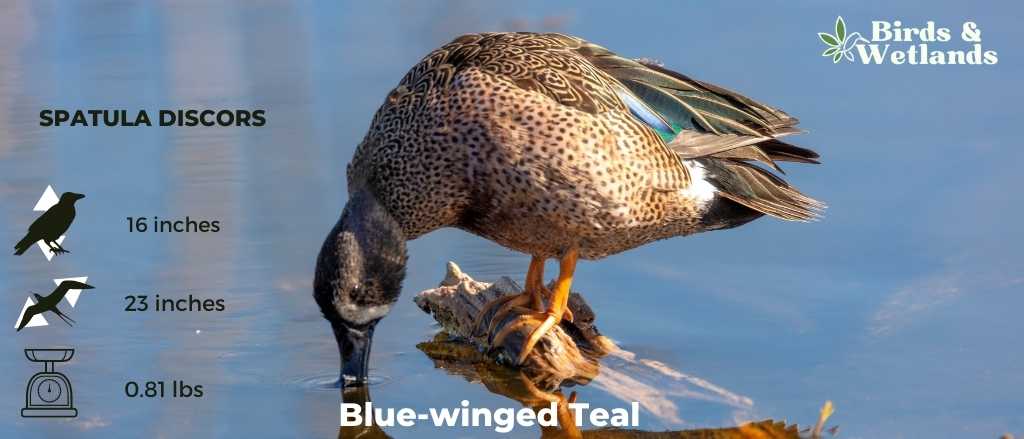
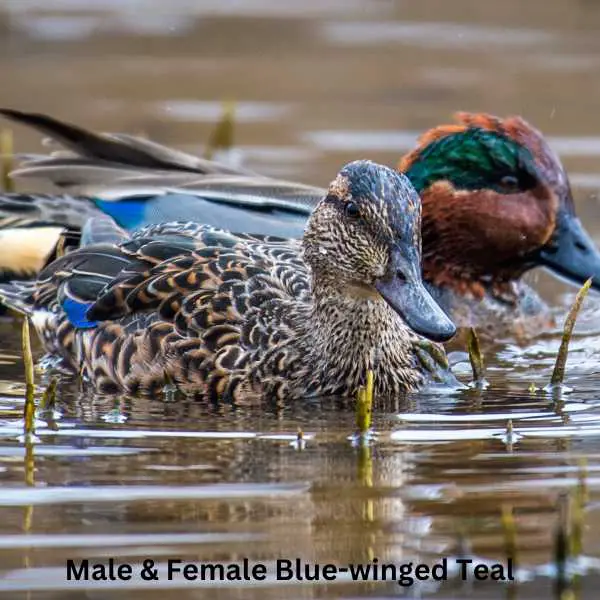
Listen to Blue-winged Teal
Scientific Name: Spatula discors
Length: 16 in
Wingspan: 23 in
Weight: 13 oz
The Blue-winged Teal is a small species of dabbling duck known for its striking plumage and its extensive migratory habits.
Appearance: Male Blue-winged Teals are quite colorful, with a slate gray head and neck, a white crescent in front of the eyes, and a predominantly brown body with specks of black. The name “Blue-winged” comes from the patch of blue feathers visible on their wings during flight. Females, in contrast, are primarily brown and subtly mottled to provide camouflage.
Diet: The Blue-winged Teal feeds mainly on plant matter, such as seeds and aquatic vegetation. However, they also supplement their diet with small invertebrates, especially during the breeding season. They are known for their “dabbling” behavior, where they feed at the surface of the water rather than diving.
Reproduction: Blue-winged Teals prefer to nest on the ground in grassy areas near water. The female typically lays a clutch of 9 to 13 eggs, which she incubates alone for about three weeks. After hatching, the ducklings can feed themselves but remain under the mother’s protection until they are capable of flying.
Northern Pintail
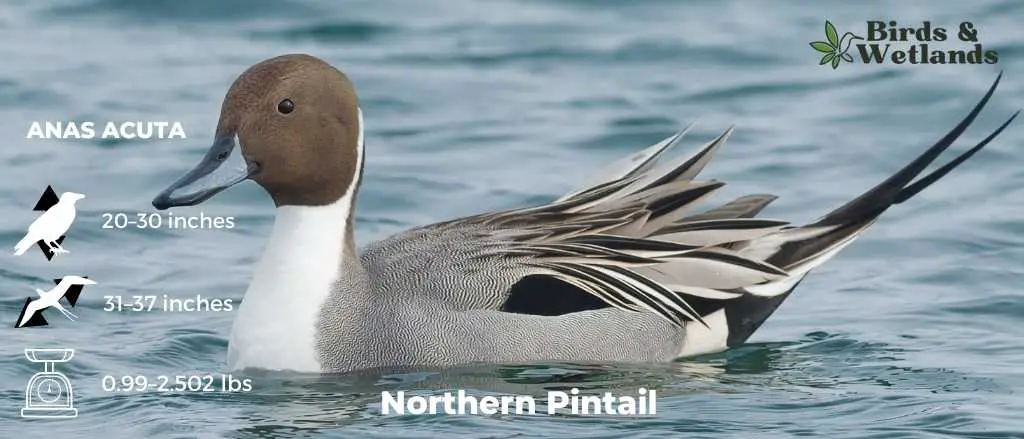
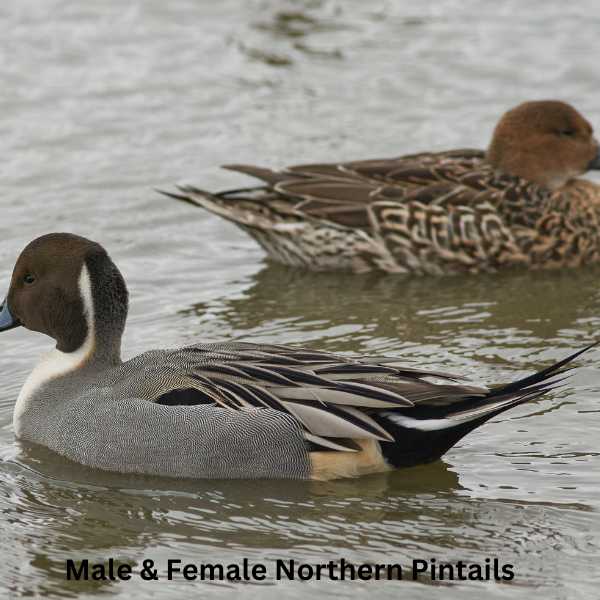
Listen to Northern Pintail
Scientific Name: Anas acuta
Length: 23–30 in
Wingspan: 31–37 in
Weight: 1 –3 lb
The Northern Pintail is a graceful species of duck recognized for their elegance in flight and their sleek bodies and long tails which is pin-shaped.
Male Northern Pintails are celebrated for their distinctive appearance, featuring a chocolate brown head, a white neck, and a grayish body. The most notable characteristic is the long, pointed tail feathers, which give this species its name. Females are more understated in color, sporting a mottled brown plumage.
Diet: Consists primarily of plant matter, including seeds and aquatic vegetation. They are also known to eat insects, especially during the breeding season. The Northern Pintail is often seen dabbling and upending in water bodies to forage for food.
Reproduction: Northern Pintails usually nest on the ground, near water bodies. The female lays a clutch of 7 to 9 eggs and is solely responsible for their incubation, which lasts for about three weeks.
Canvasback
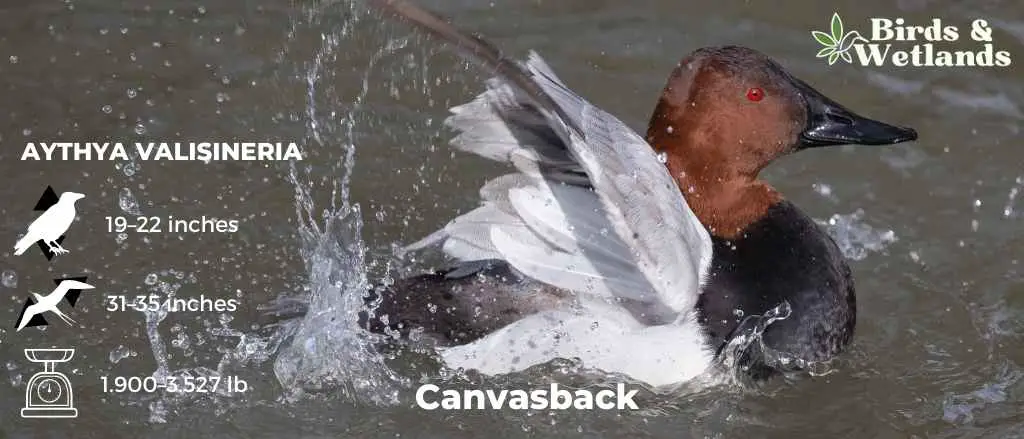
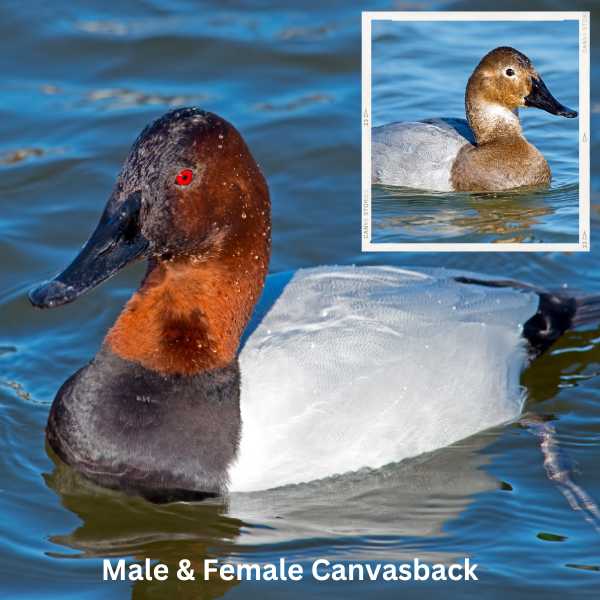
Listen
Scientific Name: Aythya valisineria
Length: 19–22 in
Wingspan: 31–35 in
Weight: 1.900–3.527 lb
The Canvasback is a large diving duck species known for its sloping forehead and long, robust bill. These distinctive birds are primarily found in the wetlands and open water bodies across the United States.
Appearance: Male Canvasbacks are easily recognized by their reddish heads, black chests, and white bodies, which gives the impression of a canvas-like texture, hence their name. Females, on the other hand, have light brown feathers and a slightly paler belly. Both genders have dark gray bills and red eyes.
Diet: Canvasbacks are primarily vegetarian, feeding on aquatic plants like wild celery, pondweeds, and algae. They also occasionally consume small aquatic animals, such as snails, insects, and crustaceans.
Reproduction: Canvasbacks typically nest over water, using marsh plants to construct their nests. The female usually lays a clutch of 5 to 11 eggs which she alone incubates for about a month.
Redhead
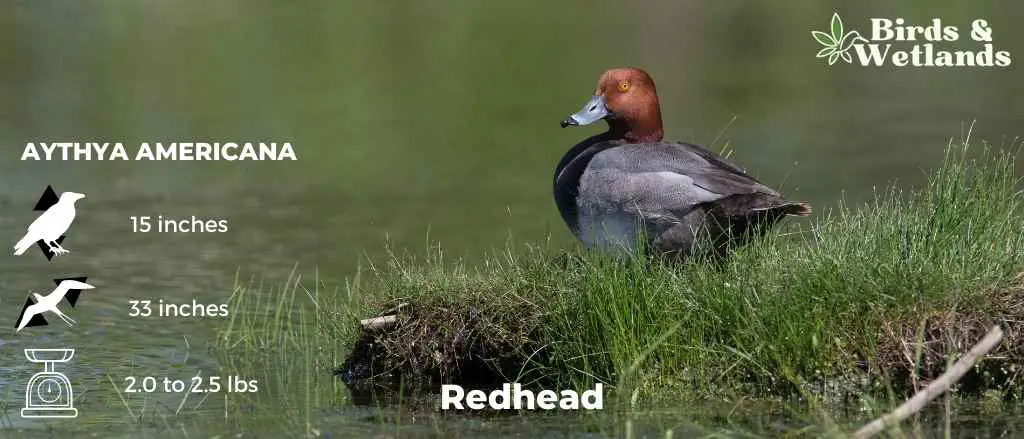

Listen
Scientific Name: Aythya americana
Length: 15 in
Wingspan: 33 in
Weight: 2.0 to 2.5 lbs
The Redhead is a medium-sized diving duck species recognized by its rounded head and broad blue bill. This bird is frequently found in wetlands, ponds, and open water bodies across the United States.
Appearance: The male Redhead is particularly striking, characterized by a coppery red head, black breast, and a gray body. The female is less colorful, featuring a brownish body and a duller, brownish-red head. Both sexes have a prominent blue bill with a black tip.
Diet: Redheads feed on a variety of items, including aquatic plants, seeds, and tubers. They also consume aquatic invertebrates, particularly during the breeding season.
Reproduction: Redheads often nest in marshes and ponds with dense vegetation.Females often lay their eggs in the nests of other ducks, a phenomenon known as brood parasitism. When nesting themselves, the female typically lays a clutch of 7 to 10 eggs and incubates them for about three weeks.
Ring-necked Duck (Aythya collaris)
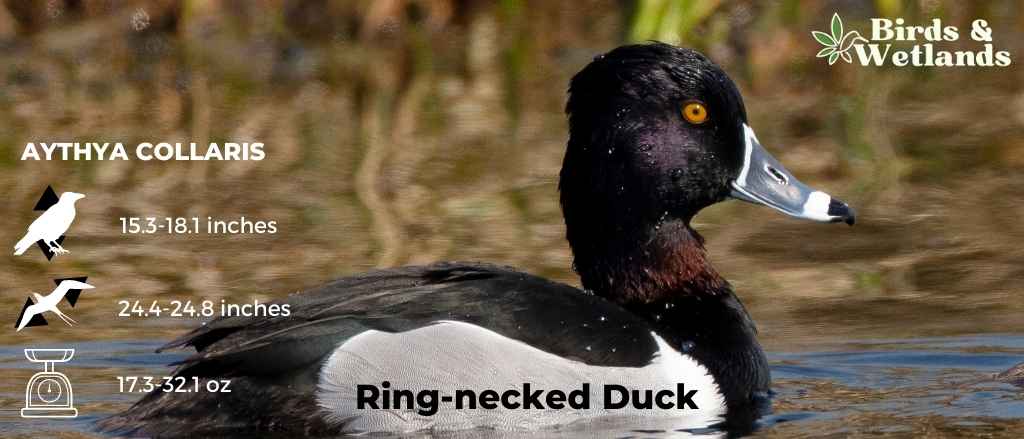

Listen
Scientific Name: Aythya collaris
Length: 15.3-18.1 in
Wingspan: 24.4-24.8 in
Weight: 17.3-32.1 oz
The Ring-Necked Duck is a small to medium-sized diving duck known for its distinctive markings and agile diving abilities.
Appearance: Male Ring-Necked Ducks are characterized by their bold black-and-white coloration, with a glossy black back, a striking white ring around the base of the bill, and two white “rings” on their flanks. Despite their name, the chestnut-colored ring around their neck is often hard to see. Females are more subtly colored with a gray-brown body and a white eye-ring.
Diet: These ducks have a varied diet that includes aquatic plants, seeds, and invertebrates, which they obtain by diving underwater in both shallow and deep water bodies.
Reproduction: The Ring-Necked Duck nests near water, often in densely vegetated areas. The female typically lays between 8 to 10 eggs, which she incubates alone, but both parents will care for the ducklings once they hatch.
Bufflehead

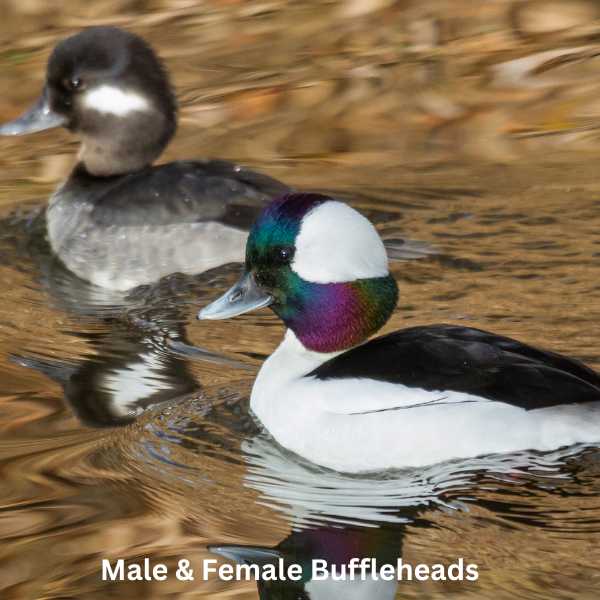
Listen to Bufflehead
Scientific Name: Bucephala albeola
Length: 13–16 in
Wingspan: 21.6 in -23.2 in
Weight: 9.5–19.4 oz
The Bufflehead is a small, compact species of diving duck known for its striking appearance and large heads and unique nesting habits.
Appearance: Male Buffleheads are easily recognized by their large, bulbous head with a green-purple iridescent sheen, a large white patch across the back of the head, and a predominantly black and white body. Females are more subtly colored, primarily in gray-brown tones with a smaller white cheek patch.
Diet: As diving ducks, Buffleheads feed by diving beneath the water’s surface. Their diet consists largely of aquatic invertebrates, such as insects, crustaceans, and mollusks, as well as some plant matter.
Reproduction: Uniquely among ducks, Buffleheads often nest in tree cavities, especially those made by Northern Flickers, a type of woodpecker. The female lays a clutch of about 6 to 11 eggs, which she incubates alone for roughly a month.
Hooded Merganser
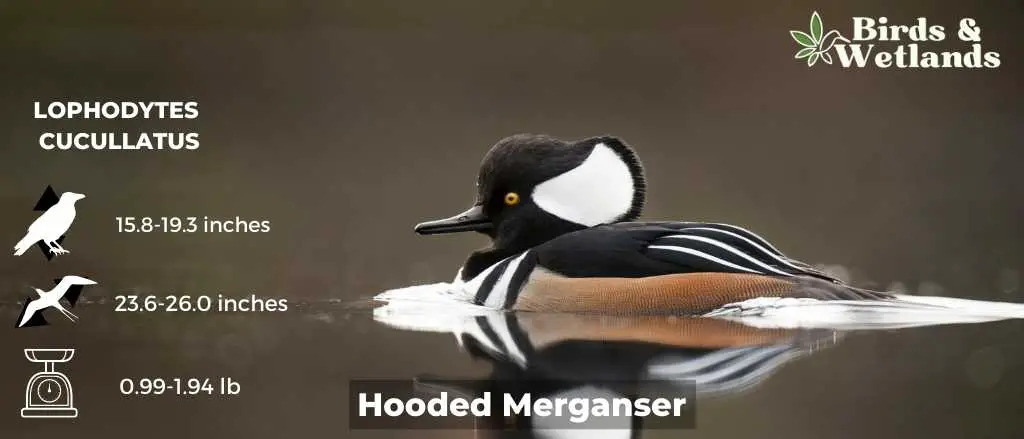
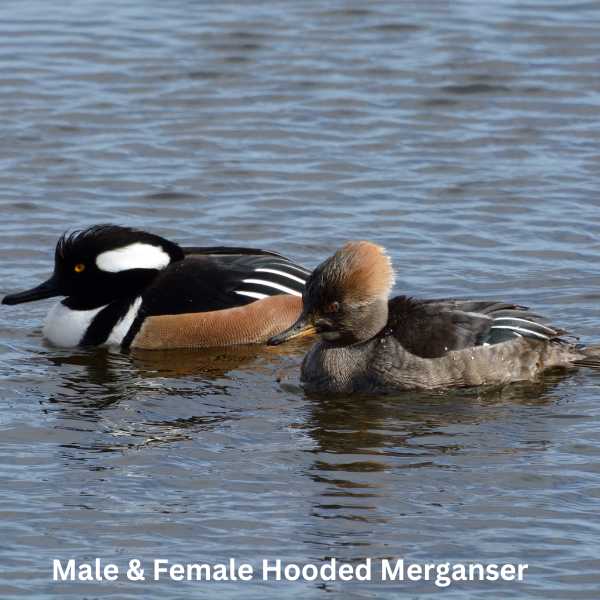
Listen to Hooded Merganser
Scientific Name: Lophodytes cucullatus
Length: 15.8-19.3 in
Wingspan: 23.6-26.0 in
Weight: 16.0-31.0 oz
The Hooded Merganser is a distinctive species of diving duck known for its showy crest and its excellent diving skills.
Appearance: Male Hooded Mergansers are especially striking with a large, fan-shaped, black and white crest, which can be expanded or contracted. They have bright yellow eyes, a dark back, and a white chest. The females have a more understated appearance with a brownish body, a smaller, reddish-brown crest, and dark eyes.
Diet: Consists of small fish, aquatic insects, and crustaceans. Their eyes are specially adapted for underwater vision, allowing them to spot and catch prey while diving.
Reproduction: Similar to Buffleheads, Hooded Mergansers often nest in tree cavities near water bodies. The female lays a clutch of about 10 to 12 eggs and incubates them alone for about a month.
Common Merganser
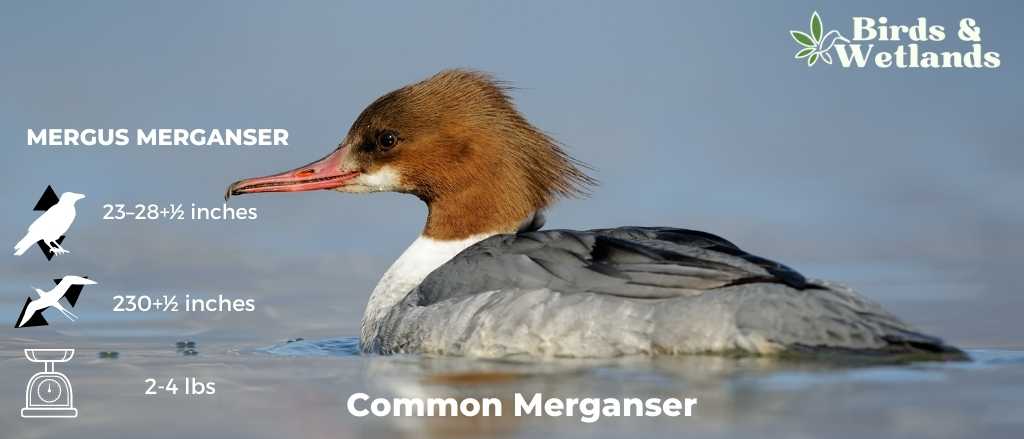
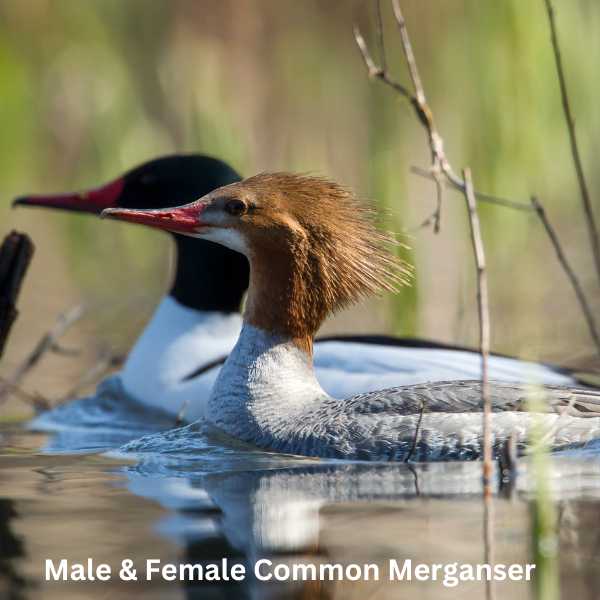
Listen:
Scientific Name: Mergus merganser
Length: 23–28 in
Wingspan: 30 – 38 in
Weight: 2 lb 0 oz – 4 lb 10 oz
The Common Merganser is a large and elegant diving duck, famous for its unique fishing abilities and seen often in the lakes, rivers, and coastal areas across North America.
Appearance: The male Common Merganser is quite striking with its dark green, almost black, crested head, bright red bill, and white body tinged with salmon-pink. The females have a reddish-brown crested head, a white neck, and a grayish body, but share the same red bill as the males.
Diet: True to their diving duck status, Common Mergansers are exceptional hunters, primarily feeding on fish. They’re also known to consume aquatic invertebrates and, on occasion, small mammals and birds. Their serrated bills are specialized to hold slippery fish tightly.
Reproduction: Like the Wood Duck, Common Mergansers also nest in tree cavities or nest boxes close to water bodies, but can also use rock crevices or holes in the ground. A clutch usually contains 9 to 12 eggs, incubated solely by the female.
American Coot
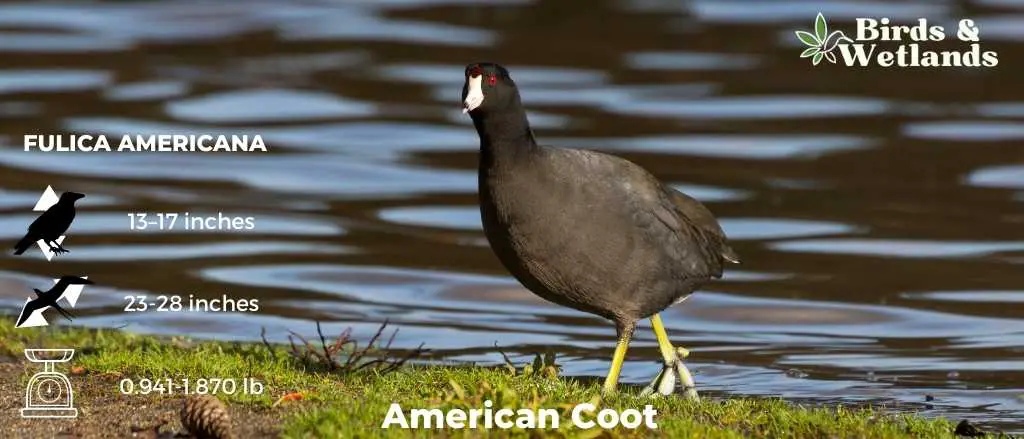
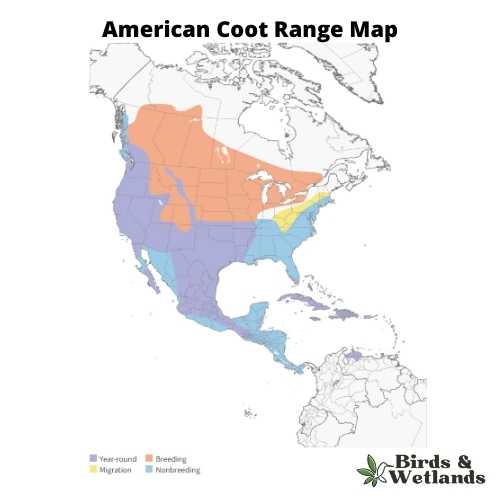
Listen:
Scientific Name: Fulica americana
Length: 13–17 in
Wingspan: 23 to 28 in
Weight: 1.270 to 1.870 lb
The American Coot is a ubiquitous water bird commonly seen in the wetlands, lakes, and ponds of North America, recognized for its adaptability and striking features.
Appearance: American Coots are easily identifiable by their slate-gray bodies, offset by a white, chicken-like bill and a red eye. Their legs are also distinctive, equipped with lobed toes, as opposed to the webbed feet seen in ducks, which assist them in navigating both land and water adeptly.
Diet: While aquatic plants form the bulk of an American Coot’s diet, they aren’t strictly herbivores. These versatile birds also consume small invertebrates and fish, demonstrating their ability to adapt and survive in a variety of habitats.
Reproduction: Nesting for the American Coot usually happens in shallow water bodies, where they construct a floating nest hidden among the vegetation. A clutch can contain between 8 to 12 eggs, all of which are incubated by both parents.
Sandhill Crane
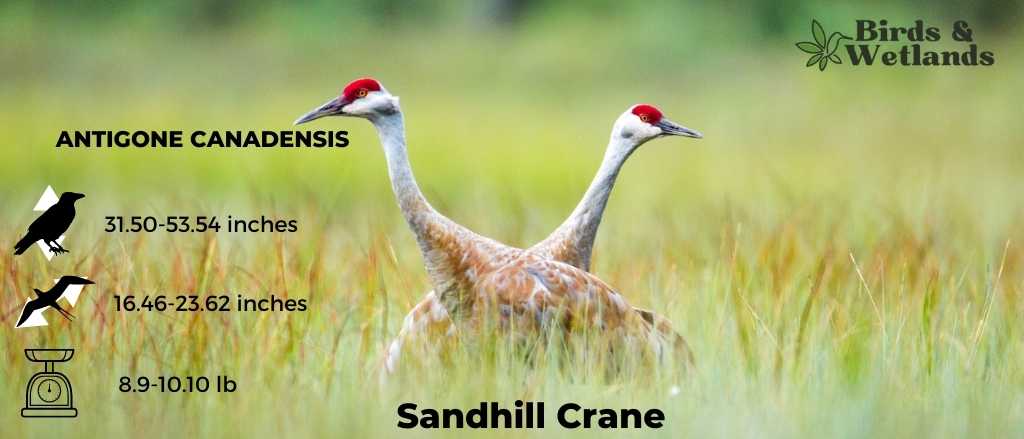

Listen:
Scientific Name: Antigone canadensis
Length: 2 ft 7-4 ft 6 in
Wingspan: 16.5–23.6 in
Weight: 4 – 4.5 kg
The Sandhill Crane is a tall, elegant bird known for its impressive size and striking appearance. They are found across North America, in habitats ranging from wetlands to grasslands.
Appearance: Sandhill Cranes are recognized for their tall stature, gray body, long legs, and long neck. Their most distinctive feature is a red forehead, which contrasts with their otherwise primarily gray plumage. During the breeding season, their gray feathers often take on a rusty-brown hue due to them rubbing iron-rich mud onto their feathers.
Diet: Sandhill Cranes are omnivorous birds and their diet is quite diverse, consisting of seeds, grains, berries, insects, small mammals, reptiles, and amphibians. They are known to forage while walking in shallow water or in fields.
Reproduction: Sandhill Cranes mate for life and their complex courtship dance is a sight to behold. They nest in marshy areas and the female typically lays two eggs.
American Wigeon
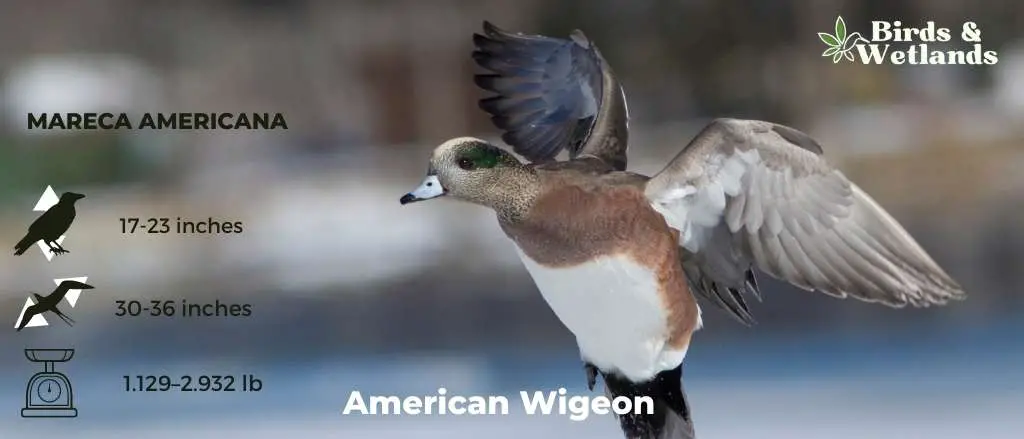
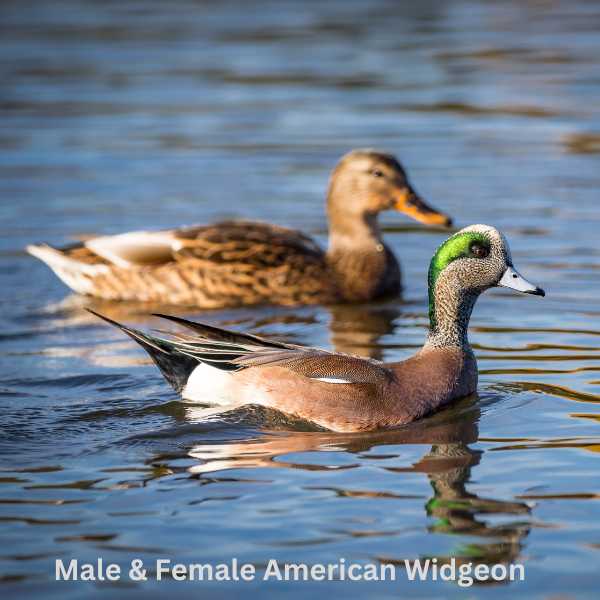
Listen to American Wigeon
Scientific Name: Mareca americana
Length: 17–23 in
Wingspan: 30–36 in
Weight: 1 –3 lb
The American Wigeon is a medium-sized duck species that is a popular sight in wetlands, ponds, and lakes and is often seen in mixed flocks with other ducks.
Males of the species are recognized by their distinctive appearance. They sport a unique white forehead and crown, coupled with a green band stretching from the eye to the back of the head. The body is mainly gray with a pinkish hue on the chest. Females are more subdued in color, with primarily gray and brown tones.
Diet: comprising mainly plant material like aquatic vegetation and grasses, but it also includes insects and other small invertebrates. They are known for a feeding behavior called “kleptoparasitism,” where they often snatch food from other ducks.
American Wigeons usually breed in the northernmost parts of North America. The females create their nests on the ground, often hidden in tall grass near water bodies. They lay a clutch of 6 to 11 eggs which they incubate for about three to four weeks and the ducklings feed on small aquatic invertebrates and aquatic insects.
Ring-billed Gull (Larus delawarensis)
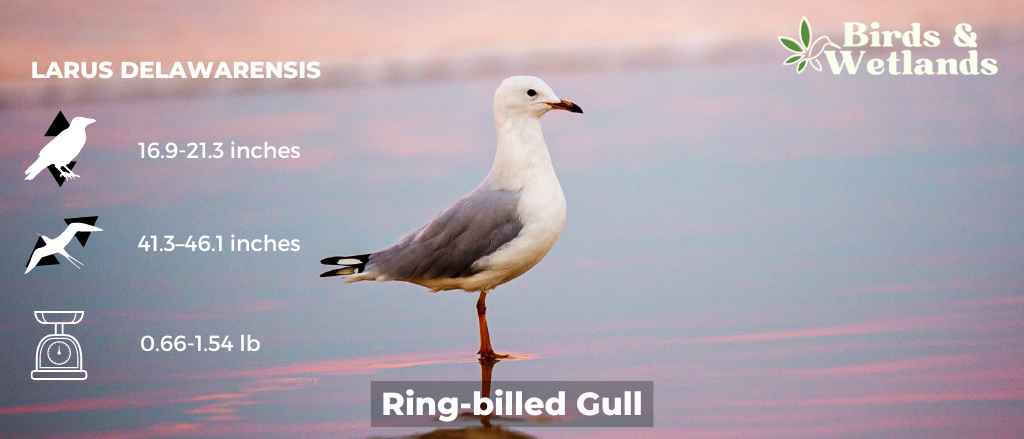
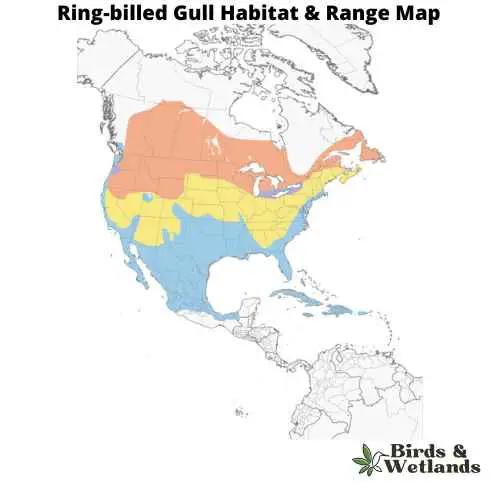
Listen:
Scientific Name: Larus delawarensis
Length: 16.9-21.3 in
Wingspan: 41.3–46.1 in
Weight:10.6-24.7 oz
The Ring-billed Gull is a common North American gull species recognized for its distinctive bill markings and widespread presence, particularly around human habitats.
Appearance: Ring-billed Gulls have a light-gray back, white head and underparts, and yellow eyes. Their most notable feature is the black ring around their yellow bill, which gives the species its name.
Diet: They have a varied diet that includes fish, insects, earthworms, rodents, grain, and garbage. They’re known for their opportunistic and scavenging feeding behaviors, often found near human-populated areas.
Reproduction: Ring-billed Gulls typically nest in large colonies on the ground near bodies of water. The female usually lays two to three eggs per season.
Common Loon

Listen:
Scientific Name: Gavia immer
Length: 24-39 in
Wingspan: 50-56 in
Weight: 6.4-13.6 lbs
The Common Loon is a large, iconic water bird that can be found in many parts of North America. It is known for its haunting calls, often heard in the early morning or late evening across the region’s lakes and ponds.
Appearance: The Common Loon is celebrated for its striking black-and-white breeding plumage, a red eye, and a robust, black bill. In winter, its plumage turns to a more subdued gray, but its large, sturdy body and pointed bill remain distinctive.
Diet: Common Loons primarily feed on fish, but also consume crustaceans, frogs, and aquatic insects. They are expert divers, capable of plunging deep underwater to catch their prey, and are often observed popping their heads above water before diving for their next meal.
Reproduction: The Common Loon nests near water, typically on lakes and larger ponds in the northern parts of North America. The female generally lays 1-2 eggs per year in a nest made from vegetation on the ground. Both parents share the responsibility of incubating the eggs and feeding the young.
Pied-billed Grebe
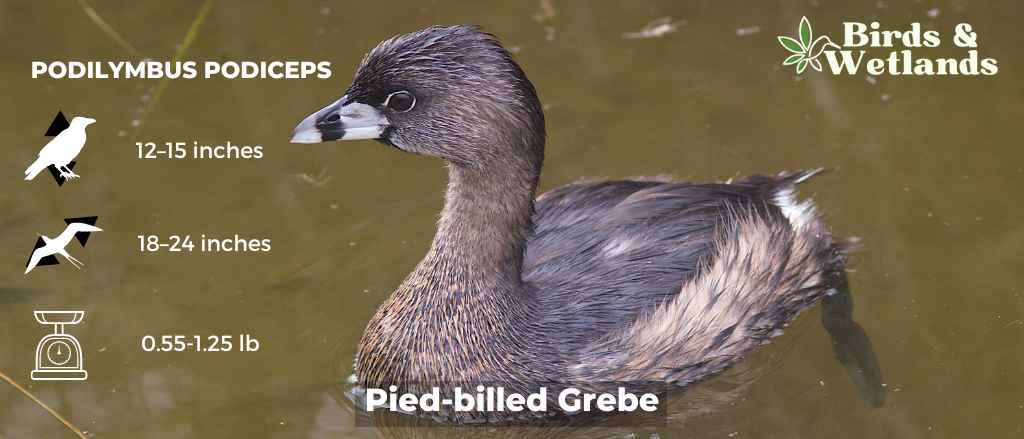
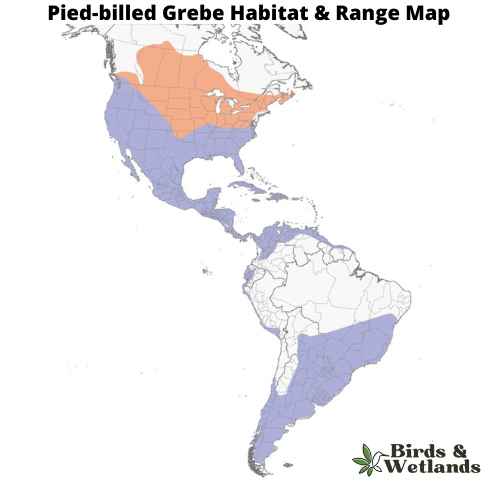
Listen:
Scientific Name: Podilymbus podiceps
Length: 12–15 in
Wingspan: 18–24 in
Weight: 8.9–20.0 oz
The Pied-billed Grebe is a small, elusive water bird well-known for its unique ability to adjust its buoyancy and often “sink” out of sight. It can be found in a wide variety of wetland habitats across the United States.
Appearance: Pied-billed Grebes have a stocky build with a short neck and a chicken-like bill that is conspicuously ringed in black during the breeding season – hence the name “pied-billed”. Their plumage is primarily a muted brown, which can vary in tone depending on the season.
Diet: Their diet consists predominantly of aquatic invertebrates, small fish, and amphibians. Pied-billed Grebes are adept divers and can stay underwater for impressive lengths of time to catch their prey.
Reproduction: Pied-billed Grebes usually nest in dense marsh vegetation, where the female lays 5 to 7 eggs. Both parents share responsibilities for incubation. After hatching, the chicks are often seen riding on their parents’ backs while they learn to navigate their aquatic world.
American Bittern (Botaurus lentiginosus)

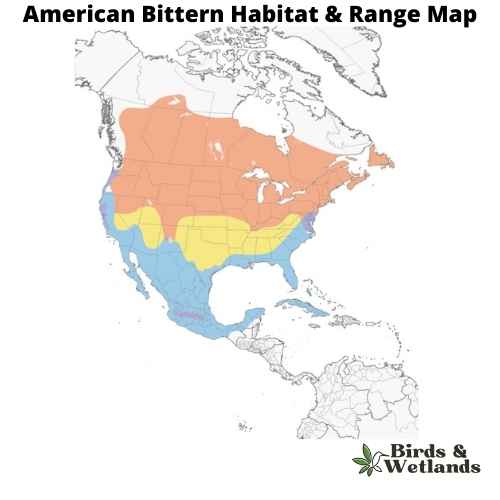
Listen
Scientific Name: Botaurus lentiginosus
Length: 23–33 in
Wingspan: 36–45 in
Weight: 0.816–2.363 lb
The American Bittern is a wading bird, often seen in North American wetlands, known for its exceptional camouflage and unique booming call.
Appearance: American Bitterns are medium-sized birds, with a stocky body, a thick neck, and relatively long legs. Their plumage is brown and heavily streaked with a variety of shades, making it an excellent camouflage against marshy vegetation. Their eyes are yellow, and they have a pointed yellow bill.
Diet: These secretive birds are carnivorous, feeding mostly on fish, but also on insects, amphibians, and small mammals. They hunt by standing still and waiting for prey to come within striking distance, then rapidly lunging forward with their long necks to seize the prey.
Reproduction: American Bitterns nest in dense wetland vegetation, often quite close to the water. The female lays a clutch of 2 to 7 eggs, and she is solely responsible for incubation and caring for the young.
Where to Spot Ohio’s Water Birds
Ohio, with its diverse ecosystems and numerous water bodies, is a wonderful place for birdwatching. Here are a few prime locations where you can spot the state’s water birds:
Magee Marsh Wildlife Area, Oak Harbor: Known as the “warbler capital of the world,” it also hosts numerous water birds such as Mallards, Northern Pintails, and Double-Crested Cormorants during the migration season.
Ottawa National Wildlife Refuge, Oak Harbor: Located along the southern shore of Lake Erie, this refuge provides habitat to water birds like the American Coot, Bufflehead, and Snowy Egret, particularly during migration periods where it’s dense vegetation provides ample food.
Cuyahoga Valley National Park, Brecksville: Alongside the Cuyahoga River, the park offers opportunities to see a variety of waterfowl especially the large birds, including the Great Blue Heron (known for its blue gray appearance), Green Heron, and Black-Crowned Night-Heron.
Killbuck Marsh Wildlife Area, Shreve: The largest remaining marshland in Ohio, the wildlife area is home to a variety of water birds such as the Great Egret, American Avocet, and Northern Shoveler.
East Fork State Park, Bethel: This park contains one of the largest man-made lakes in Ohio, attracting a diverse array of water birds including the Surf Scoter, Red-breasted Merganser, and Greater Scaup.
Mosquito Creek Wildlife Area: Located in northeast Ohio, this area includes a large reservoir and diverse wetland habitats that attract a variety of water birds.
Hoover Reservoir: Located in central Ohio near Columbus, this reservoir is a notable spot for water birds including gulls, dabbling ducks, and wading birds. You can also see geese such as the Snow goose, known for its pink legs.
Shawnee State Park: Located in the Appalachian foothills near the Ohio River, this park includes large lakes and wetlands that attract water birds.
Winous Point Marsh Conservancy. Covering 5,000 acres, these freshwater marshes provides vital habitat for migratory water birds. Species commonly seen include the Mallard, Blue-winged Teal, American Coot, and Great Blue Heron, among other waterfowl and shorebirds.
What threatened species of water birds are found in Ohio?
There are several species of water birds in Ohio that are considered threatened, meaning they are at risk due to factors such as habitat loss, pollution, and climate change. Some of these include:
- Least Tern: This is the smallest of the American terns. They are threatened primarily due to habitat loss and disturbance of nesting sites.
- Piping Plover: This small, sand-colored shorebird nests on open sandy beaches, which are often prime locations for human recreation. This causes disturbances that can lead to nesting failure.
- Black Tern: These birds breed in freshwater marshes and are threatened by habitat loss due to the draining and alteration of wetlands.
- Common Tern: Like other terns, they are impacted by habitat loss and disturbances to their nesting sites.
- Reddish Egret: While it’s not a regular resident of Ohio, it is considered threatened and sightings are rare.
- King Rail: This largest North American rail is often found in marshes and is threatened by wetland destruction.
| Neighboring State | Best Spots for Birdwatching |
|---|---|
| Pennsylvania Water Birds | Conneaut Harbor, Presque Isle State Park, Moraine State Park |
| West Virginia Water Birds | Ohio River Islands National Wildlife Refuge, Canaan Valley National Wildlife Refuge, New River Gorge National Park |
| Kentucky Water Birds | Daniel Boone National Forest, Lake Cumberland State Resort Park, Ballard Wildlife Management Area |
| Indiana Water Birds | Eagle Creek Park, Goose Pond Fish and Wildlife Area, Indiana Dunes National Park |
| Michigan Water Birds | Shiawassee National Wildlife Refuge, Tawas Point State Park, Seney National Wildlife Refuge |

